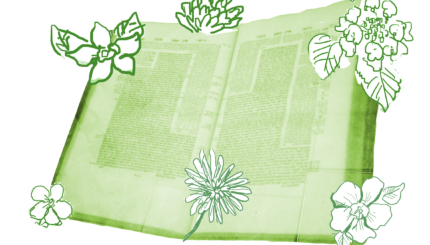The major political and intellectual shifts of the late 18th and early 19th centuries resulted in dramatic upheavals to the traditional patterns of Jewish life in Europe. While some Jews responded to these changes by advocating for reform of Judaism from within, others held fast to tradition. But even the patterns of traditionalism that emerged in this period were not seamlessly continuous with a premodern past. Rather, the practices and beliefs that would come to be termed “Orthodox Judaism” were shaped in the crucible of modern conditions.
Cracks in the Foundation
In Europe prior to the 18th century, Jewish life was defined in every way by belonging to the institutionalized Jewish community, the kehilla. Across Europe and the Ottoman lands, the kehilla functioned as a “state within a state,” containing its own system of courts led by rabbis, and providing its own basic social services such as education and support for the sick and elderly.

Rabbi Moses Sofer, also known
as the “Hatam Sofer
Beginning after the French Revolution, legal Emancipation for Europe’s Jews spread gradually across Western and Central Europe. And so, over the course of the nineteenth century, the autonomous Jewish community legally ceased to exist. The collectivity lost its coercive powers and Jews were free to operate as individuals in a larger society.
At the same time, leaders of the Haskalah introduced Enlightenment ideas into the traditional Jewish community, advocating for a more expansive curriculum which included secular studies and instruction in Hebrew language. Most significantly, Enlightenment thinkers, and leaders of the burgeoning Reform movement, flouted the authority of rabbinic elites, challenging the very foundation of the traditional system.
Initial Responses
Although many Jews saw the appeal of the Reform movement and the allure of secular Jewish life, most clung to their understanding of traditional Judaism as the only authentic form of Jewish life. In the German lands, where the ideological battles over tradition and modernity were most fierce, an overwhelming majority of Jews still followed traditional Judaism in the mid-19th century. By the close of the First World War, however, traditional Jewry’s ranks had declined to between 10 and 20 percent of the German-Jewish population.
Traditionally-minded Jews were not always completely at odds with the program of the Enlightenment, as they, too, recognized the material benefits of the new laws, and could not reject them wholesale. On the other hand, the lifting of restriction on movement and settlement posed serious challenges to observance and to communal coherence, and it was not long before traditionalists began to articulate a fuller platform of opposition.
“That Which is New is Forbidden by the Torah”
The activities of Rabbi Moses Sofer (1762-1839)–called the “Hatam Sofer” after the most famous of his written works–are particularly important to understanding emergent Orthodoxy in the modern age.
After growing up in Frankfurt, Sofer left Germany and spent the rest of his life serving in communities in Moravia and Hungary, most significantly as rabbi of Pressburg (Bratislava). It was from this Hungarian base that he waged his long-standing campaign against any form of deviation from the traditional modes of Jewish practice, expressed pithily in his slogan hadash assur min ha-Torah–that which is new is biblically prohibited.
Secession Campaigns in Germany
Although the organized Jewish kehilla was rendered obsolete by Jewish Emancipation, some German Jewish institutions were still in place to provide the basic services of communal life (ritual slaughter, rabbinic and cantorial services, ritual baths, cemeteries, etc.). These services were organized under the Jüdische Gemeinde (Jewish Community), the upkeep of which all Jews were obligated, by state law, to pay dues. As control of the Gemeinde fell to Reform activists and leaders, the Orthodox sought means to legally separate themselves from this encompassing collective.

Rabbi Samson Raphael Hirsch
Samson Raphael Hirsch (1808-88), a prominent Frankfurt rabbi, argued that paying dues to Reform-led activities lent support to an inauthentic Judaism. Following a long and arduous campaign, in 1876 the Prussian government authorized the power of secession, a law granting permission to the Orthodox to legally split from the Reform-dominated Jewish community.
Religious Hierarchy and the non-Observant Jew
Although some responses to non-observance and the Reform movement took a hard-line approach of complete separation from all activities of the organized Jewish community, a more nuanced stance was also expressed. For example, Rabbi Jacob Ettlinger of Altona, Germany (1798-1871) crafted a vision of Judaism that did not fully exclude those who strayed from observant life. He called for a conceptual scheme based on an internal hierarchy within Judaism, in which all Jews still belonged to a single collective, even as it recognized that Orthodoxy was unique in fulfilling Judaism to its fullest.
Traditionalism in Eastern Europe
Change came somewhat later to Eastern Europe than to Germany and the Austro-Hungarian lands. In the East, Jewish communities were endowed with particular social structures that allowed for the endurance of traditional patterns of Jewish life. The Hasidic movement and its voluntary organization around the court of the tsaddik, the presence of large yeshivot that transcended local communal institutions, and the presence of smaller societies and confraternities within communities all cushioned the blow to the disbanded kehilla.
Also, in Eastern Europe, Jews often formed an absolute majority in the small towns where they lived, diminishing the impulse for acculturation. And unlike in Germany, the feudal character of the economies of Eastern Europe meant that Jews did not have non-Jewish bourgeois counterparts considered worthy of emulation.
Coping with Change in the East
However, with the reforms of Tsar Alexander II in the 1850s and early 1860s, Russia’s economic foundation shifted from serfdom to industrial capitalism, and Jewish settlement was no longer legally limited to the Pale of Settlement. These economic and legal changes uprooted the traditional patterns of Jewish life in smaller towns, shtetlekh (plural for shtetl), propelling many Jews into large and middle-sized towns, and ending the already diminished autonomy and authority of the traditional Jewish community.
In response to these changes, many Jews sought to continue to operate within the framework of tradition and the social frameworks that supported it. Thus, in opposition to Enlightenment and reform, Eastern European Orthodoxy crystallized.
Also at this time a “third way” between the perceived outmoded forms of traditional life and the failures of Enlightened integration was to be found in the nascent Jewish nationalist movement, which transformed the symbols and social concepts of Jewish traditional society into secular instruments for national association. The preservation of Jewish traditional society and collective Jewish existence followed by its rapid disintegration were critical for the development of Jewish nationalism and Zionism in Eastern Europe in the later part of the 19th century.


